In this page, you can find the complete solutions of the first exercise of
Measures of Dispersion chapter from Basic Mathematics Grade XI book published
and distributed by Sukunda Pustak Bhawan.
In the above-mentioned book, sequence and series is the 14th chapter and has
two exercises only. Out of which, this is the solution of the first exercise
in which we have to deal with the mean, standard deviation, and coefficient of
variation.
Related Solutions:
Grade 11 Basic Mathematics by Sukunda Pustak Vawan Notes and Solutions | Nepal
Grade 11 Sequence and Series Exercise 1 Solutions | Basic Mathematics Grade XI by Sukunda Pustak Bhawan
Disclaimer:
Answers mentioned here are not solved by teachers. These are the solutions
written by a student of Grade 11. Answers are all correct. However, the
language or process of solving the questions might be informal and in
examinations, you might have to add little more language and show more
calculations than what has been done here. So, we highly encourage you to
view these solutions as guide rather than just copying everything mentioned
here. Few questions have been typed while most of them have been updated as
pictures.
Unit 14 Measures of Dispersion
Part 2 Methods of measuring dispersion: Standard Deviation
1 a) Find the standard deviation from the following set of observations.
20 25 30 36 32 43
Solution: Arranging the given data in a table and computing the
values,
| $x$ | $x^2$ |
| 20 | 400 |
| 25 | 625 |
| 30 | 900 |
| 36 | 1296 |
| 32 | 1024 |
| 43 | 1849 |
| $\sum x = 186$ | $\sum x^2 = 6094$ |
Here,
$\sum x = 186$
$\sum x^2 = 6094$
$n = 6$
$n = 6$
$\sigma = ?$
We know,
$\sigma = \sqrt{ \dfrac{ \sum x^2}{n} - \left ( \dfrac{ \sum fx}{n}
\right )^2 }$
$= \sqrt{ \dfrac{6094}{6} - \left ( \dfrac{186}{6} \right )^2}$
$= \sqrt{1015.66 - 31^2}$
$= 7.39$
Hence, the required standard deviation of the given data is 7.39.
1 b) Daily expenditure of 6 families are given below:
1 b) Daily expenditure of 6 families are given below:
Rs 240, Rs 180, Rs 320, Rs 160, Rs 260, Rs 400
Find the standard deviation.
Solution: Arranging the given data in a table and computing the
values,
| $x$ | $x^2$ |
| 240 | 57600 |
| 180 | 32400 |
| 320 | 102400 |
| 160 | 25600 |
| 260 | 67600 |
| 400 | 160000 |
| $\sum x = 1560$ | $\sum x^2 = 445600$ |
Here,
$\sum x = 1560$
$\sum x^2 = 445600$
$n = 6$
$n = 6$
$\sigma = ?$
We know,
$\sigma = \sqrt{ \dfrac{ \sum x^2}{n} - \left ( \dfrac{ \sum fx}{n}
\right )^2 }$
$= \sqrt{ \dfrac{445600}{6} - \left ( \dfrac{1560}{6} \right )^2}$
$= \sqrt{75266.67 - 260^2}$
$= 81.65$
Hence, the required standard deviation of the given data is 81.65.
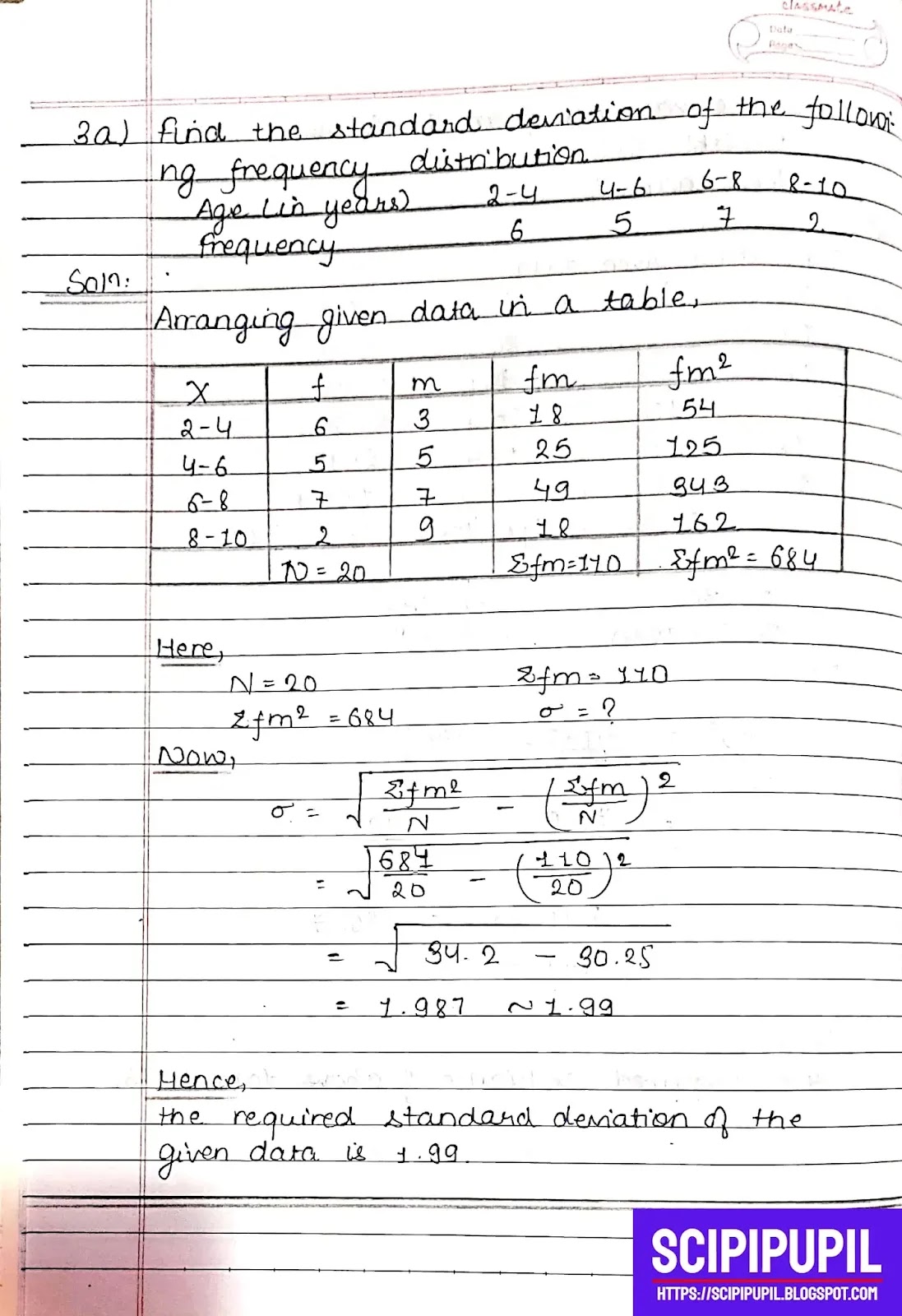
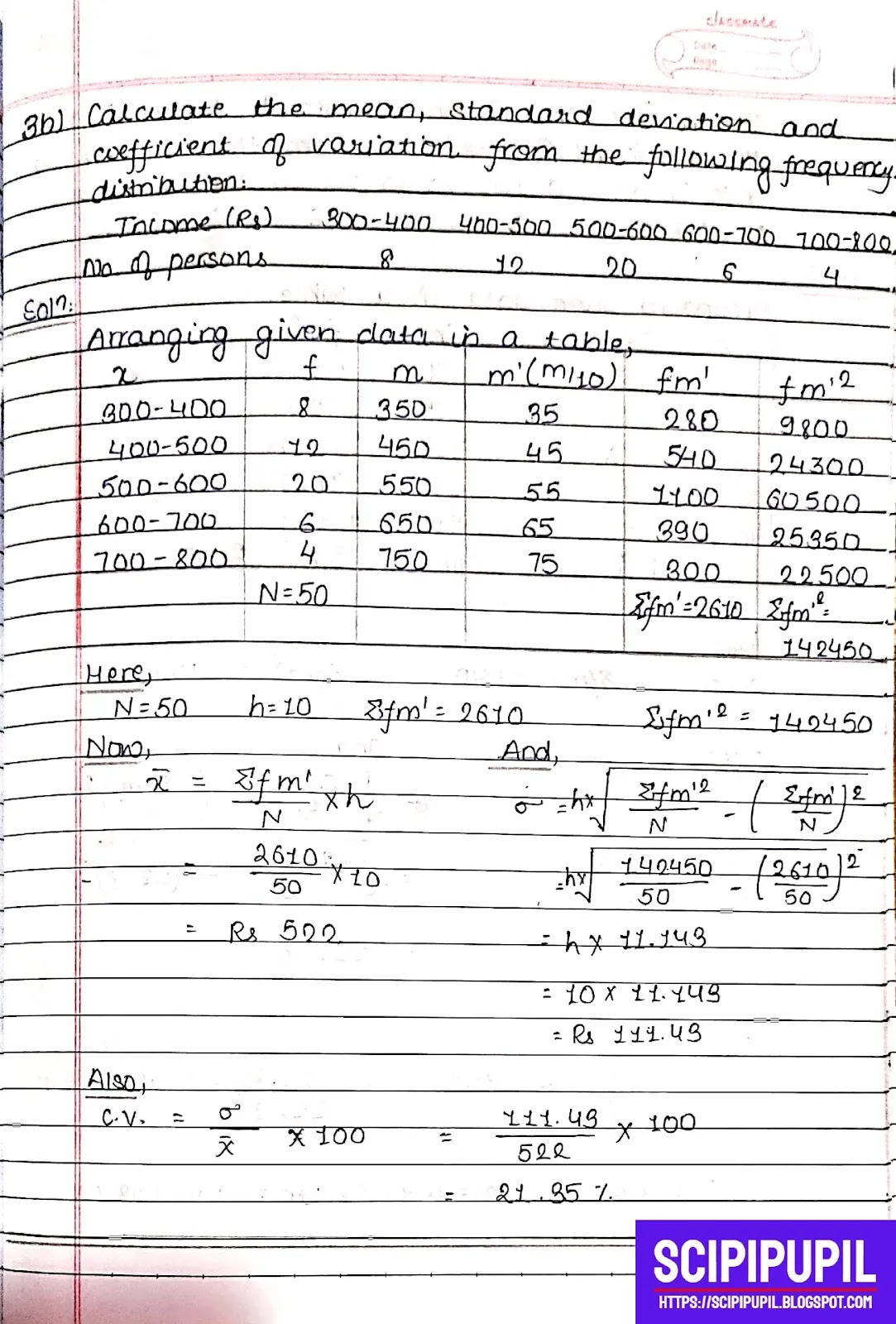
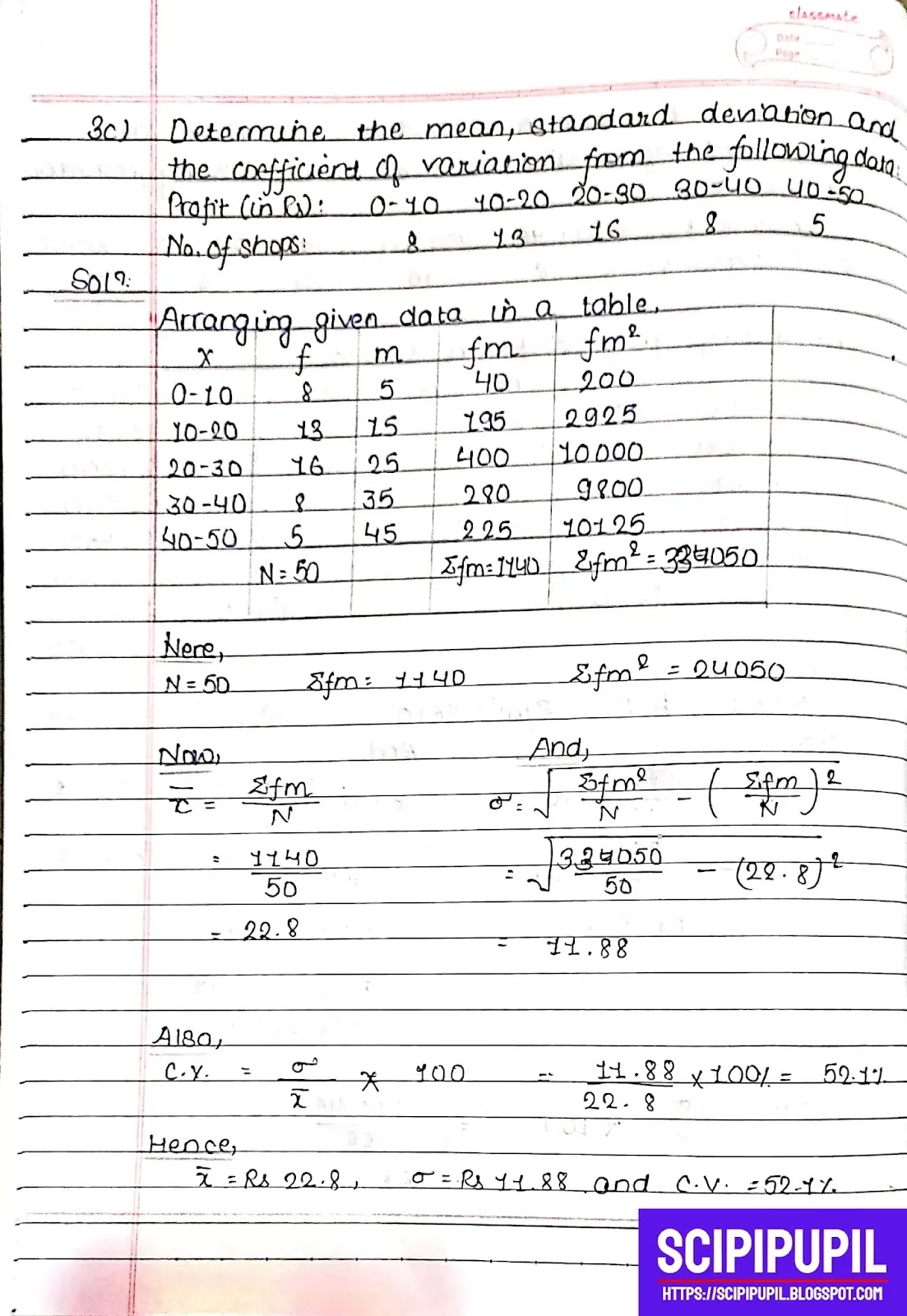

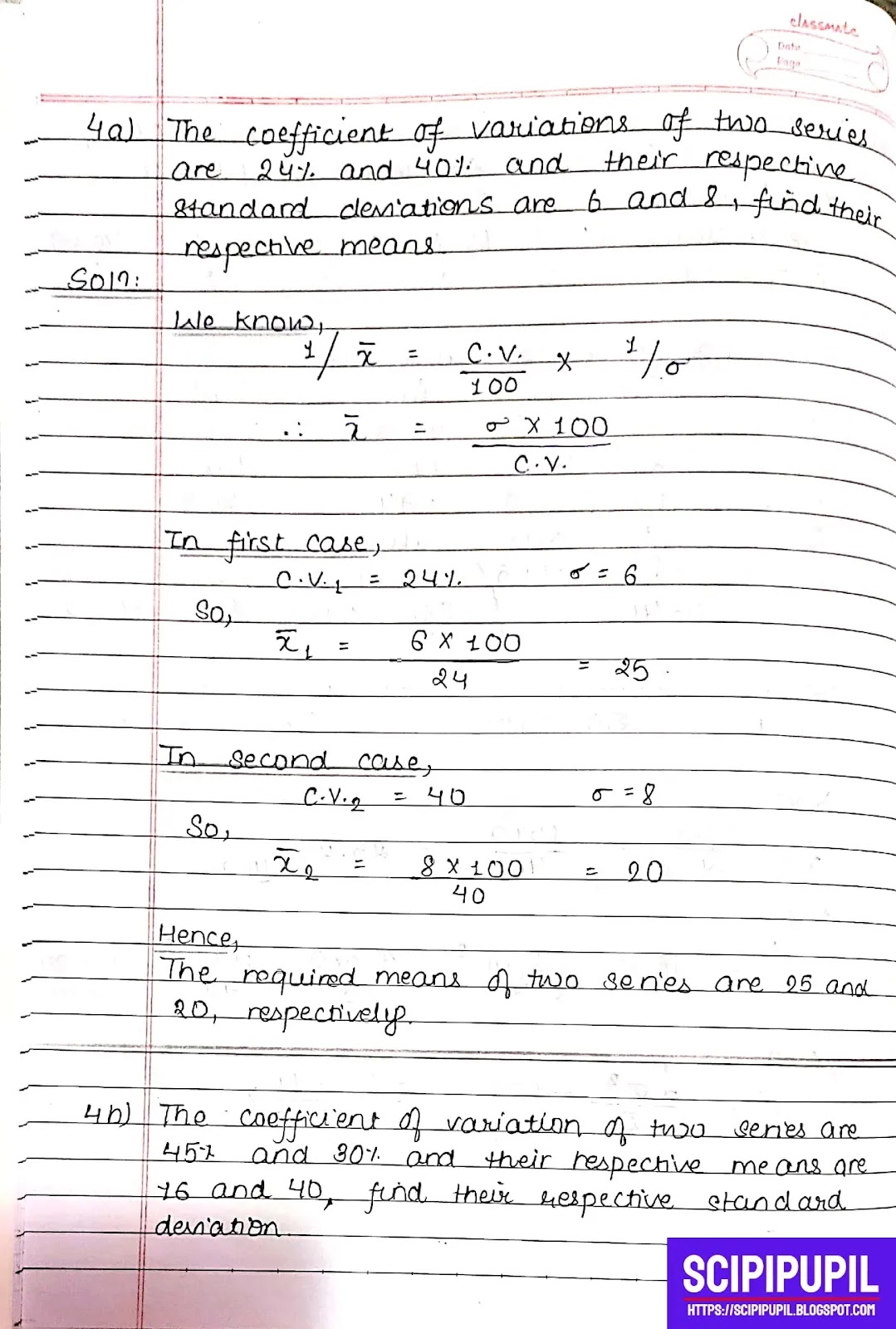
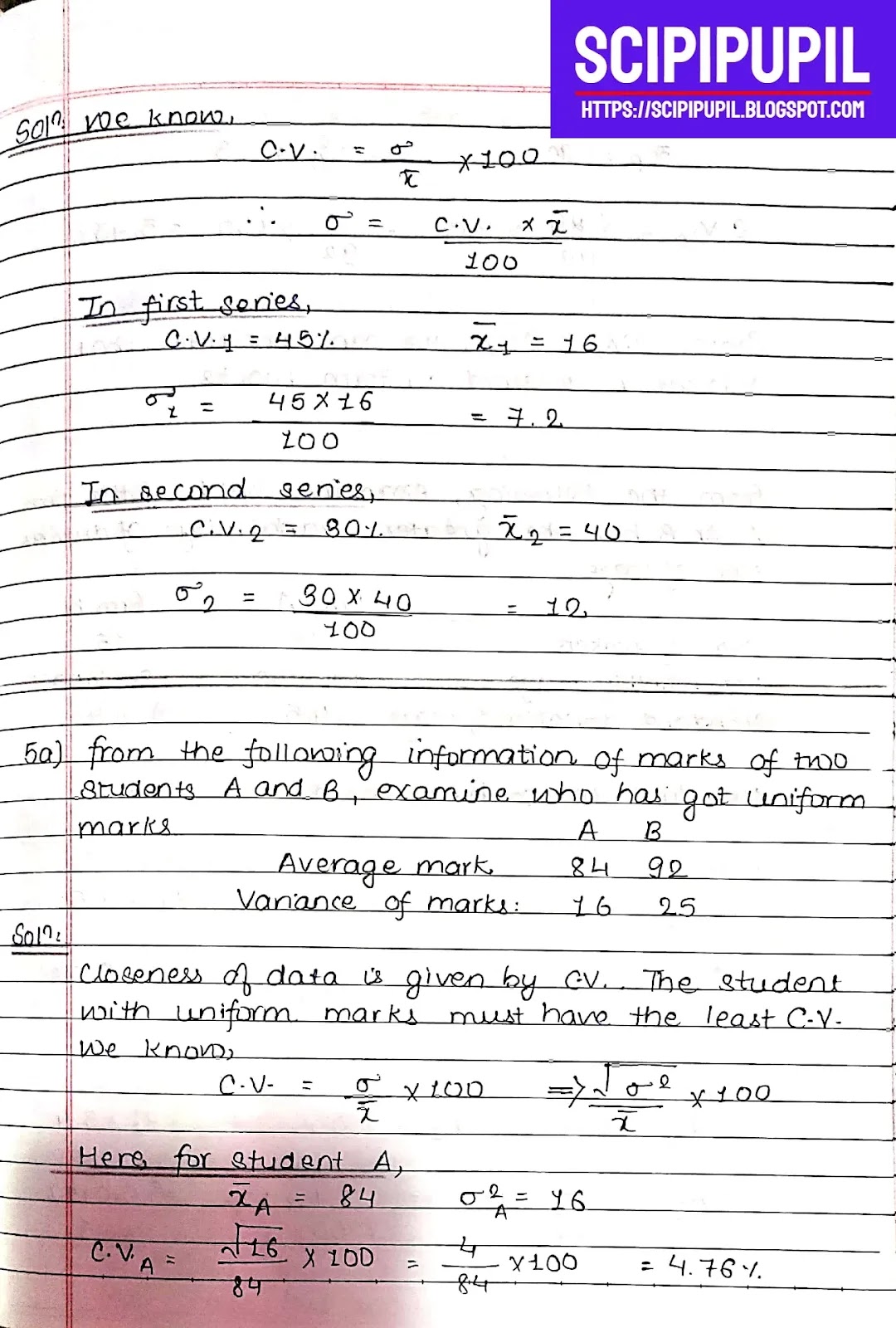
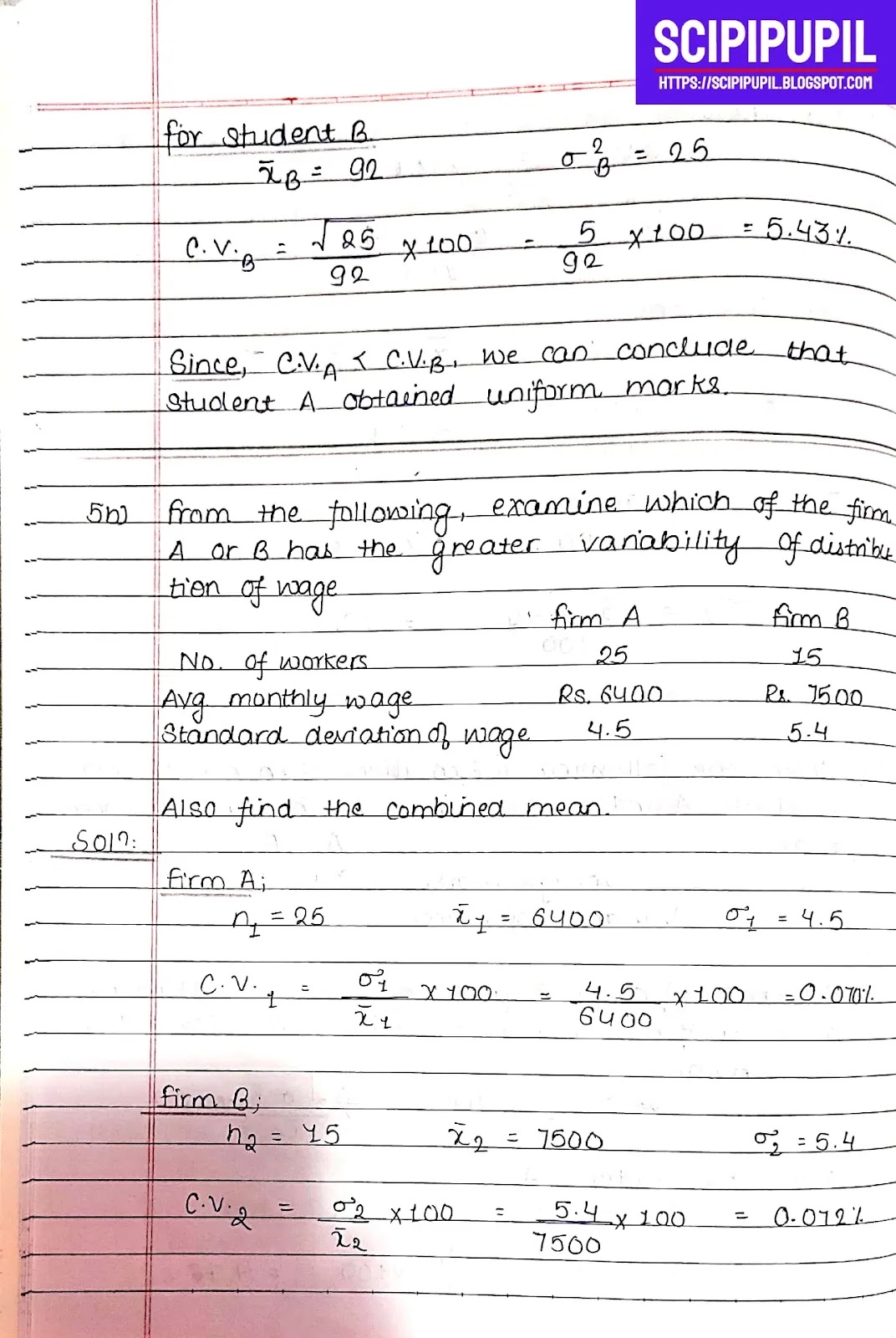
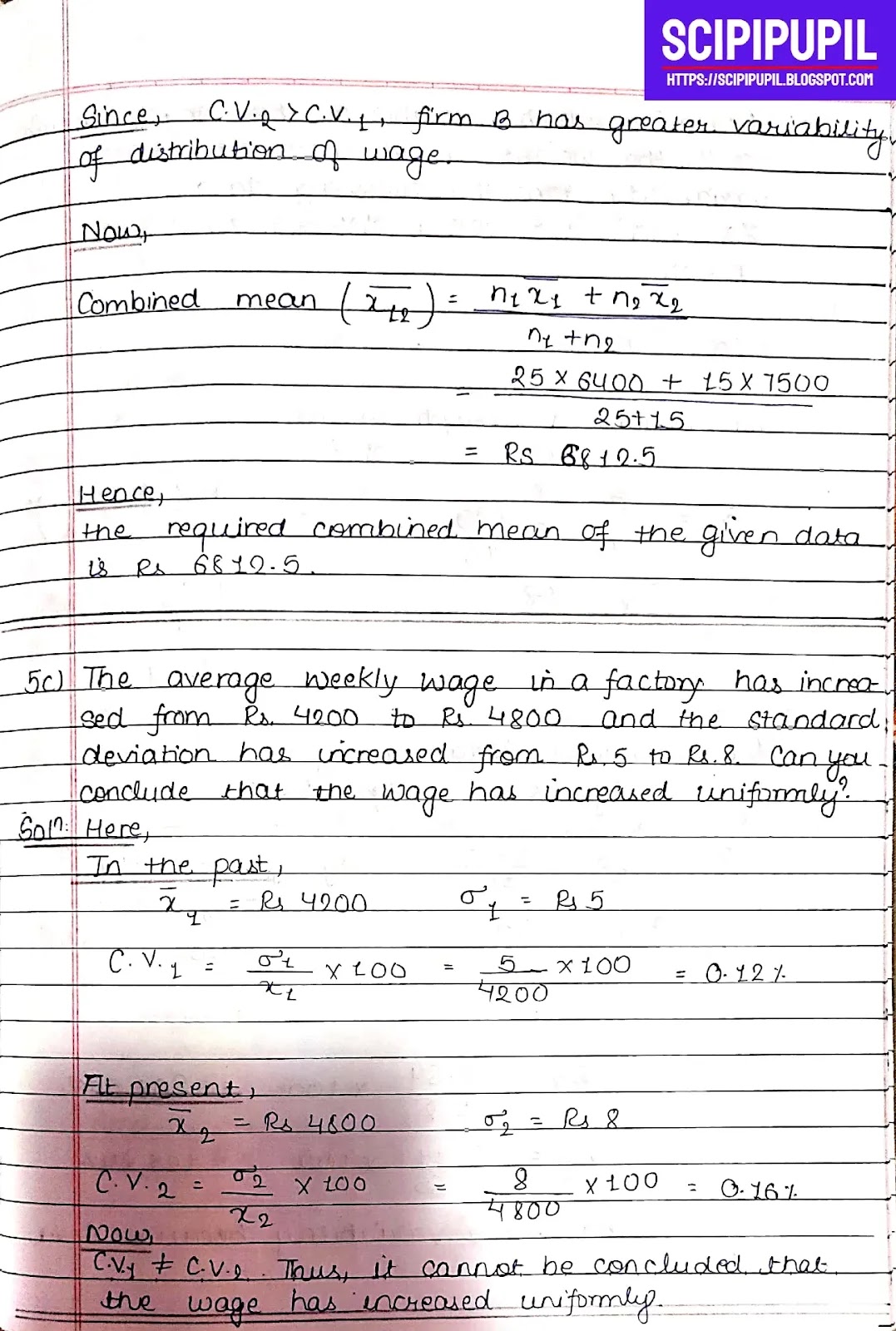
6 a) Following are the marks obtained by the students X and Y in 6 tests
of 100 makrs each:
| Test | 1 | 2 | 3 | 4 | 5 | 6 |
| X | 56 | 72 | 48 | 69 | 64 | 81 |
| Y | 63 | 74 | 45 | 57 | 82 | 63 |
If the consistency of the performance is the criteria for awarding a prize,
who should get the prize?
Solution:
The lower the coefficient of variation, the more the consistency is.
Here, $n = 6$ for both X and Y.
Computing mean and standard deviation of student X
| $x$ | $x^2$ |
| 56 | 3136 |
| 72 | 5184 |
| 48 | 2304 |
| 69 | 4761 |
| 64 | 4096 |
| 81 | 6561 |
| $\sum x = 390$ |
$\sum x^2 = 26042$ |
$\sum x = 390$
$\sum x^2 = 26042$
$n = 6$
$n = 6$
$\sigma = ?$
We know,
$\sigma_X = \sqrt{ \dfrac{ \sum x^2}{n} - \left ( \dfrac{ \sum
fx}{n} \right )^2 }$
$= \sqrt{ \dfrac{26042}{6} - \left ( \dfrac{390}{6} \right
)^2}$
$= 10.74$
$\overline{x}_X = \dfrac{ \sum x}{n}$
$= \dfrac{ 390}{6}$
$= 65$
$\therefore C.V._X = \dfrac{ \sigma _X}{ \overline{x} _X} * 100$
$= \dfrac{10.74}{65} * 100$
$= 16.52 \%$
Computing mean and standard deviation of student Y
| $x$ | $x^2$ |
| 63 | 3969 |
| 74 | 5476 |
| 45 | 2025 |
| 57 | 3249 |
| 82 | 6724 |
| 63 | 3969 |
| $\sum x = 384$ |
$\sum x^2 = 25412$ |
$\sum x = 384$
$\sum x^2 = 25412$
$n = 6$
$n = 6$
$\sigma = ?$
We know,
$\sigma_Y = \sqrt{ \dfrac{ \sum x^2}{n} - \left (
\dfrac{ \sum fx}{n} \right )^2 }$
$= \sqrt{ \dfrac{25412}{6} - \left ( \dfrac{384}{6} \right
)^2}$
$= 11.80$
$\overline{x}_Y = \dfrac{ \sum x}{n}$
$= \dfrac{ 384}{6}$
$= 64$
$\therefore C.V._X = \dfrac{ \sigma _Y}{ \overline{x}_Y} *
100$
$= \dfrac{11.80}{64} * 100$
$= 18.44 \%$
Since, Coefficient of Variation of student X is less than that of
student Y, student X should get the prize for his better consistency.
7 b) The monthly wages paid to the workers of two firms A and B belonging
to the same industry have been presented below.
| Firm A | Firm B | |
| No. of workers | 50 | 40 |
| Average monthly wage | Rs. 63 | Rs. 54 |
| Variance of wages | 81 | 36 |
Determine the combined mean and combined standard deviation of the
combined group of 90 workers.
Solution:
For Firm A,
$n_1 = 50$
$\overline{x}_1 = Rs. 63$
$\sigma _1^2 = 81$
For Firm B,
$n_2 = 40$
$\overline{x}_1 = Rs. 54$
$\sigma _1^2 = 36$
Now,
Combined mean $\overline{x}_{12}$ $= \dfrac{n_1 \overline{x}_1 + n_2 \overline{x}_2}{n_1 + n_2}$
$= \dfrac{50 * 63 + 40 * 54}{50 + 40}$
$= \dfrac{5310}{90}$
$= 59$
And,
$d_1 = x_1 - x_{12}$
$\therefore d_1 = 63 - 59 = 4$
$d_2 = x_{12} - x_2$
$\therefore d_2 = 59 - 54 = 5$
$\sigma _{12} = \sqrt{ \dfrac{n_1 ( d_1^2 + \sigma _1^2) + n_2 (d_2^2 +
\sigma _2^2) }{n_1 + n_2} }$
$= \sqrt{ \dfrac{50 (81 + 16) + 40 (36 + 25)}{50+ 40} }$
$= \sqrt{ \dfrac{50 * 97 + 40 *61}{90}}$
$= 9$
8 a) The arithmetic mean and the standard deviation of a series of 20
items as calculated by a student were 20 cm and 5 cm resepectively.
But while calculating an item 13 was misread as 30. Find the correct
mean and standard deviation.
Solution:
Here,
Total number of observations (n) = 20
Inaccurate mean ($\overline{x}_1$) = 20 cm
Inaccurate standard deviation ($\sigma_1$) = 5 cm
Given,
13 was misread as 30
Now,
Total sum of observations in in accurate mean ($\sum x_1$) =
$\overline{x}_1 * n$
$= 20 * 20$
$= 400$
Since 13 was misread as 30,
Total sum of observations after correcting ($\sum x_2$) = $400 - 30 + 13$
$= 383$
Accurate mean $\overline{x}_2$ = $\dfrac{ \sum x_2}{n}$
$= \dfrac{383}{20}$
$= 19.15 \text{cm}$
And,
$(\sigma_1)^2 = \dfrac{ \sum x_1^2}{n} - \left ( \dfrac{ \sum x_1 }{n}
\right )^2$
$or, 5^2 = \dfrac{ \sum x_1^2}{20} - (20)^2$
$or, 425 * 20 = \sum x_1^2$
$\implies \sum x_1^2 = 8500$
Since 13 was misread was 30
Accurate sum of the square of the observations ($\sum x_2^2$) = $8500 -
30^2 + 13^2$
$= 7769$
Again,
Accurate standard deviation of the given data is
$\sigma _ 2 = \sqrt{ \dfrac{ \sum x_2^2}{n} - \left ( \dfrac{\sum x_2}{n}
\right)^2 }$
$= \sqrt{\dfrac{7769}{20} - \left ( \dfrac{383}{20} \right)^2}$
$= \sqrt{21.7275}$
$= 4.66 \text{cm}$
About the Textbook:
Name: Basic Mathematics Grade XI
Author(s): D.R. Bajracharya | R.M. Shresththa | M.B. Singh | Y.R.
Sthapit | B.C. Bajracharya
Publisher: Sukunda Pustak Bhawan (Bhotahity, Kathmandu)
Telephone: 5320379, 5353537
Price: 695 /- (2078 BS)
Buy this book: Basic Mathematics : Grade XI – Sukunda Publication


10 Comments
q no 6a) , 7b plsss
ReplyDeleteAdded!
Deleteq no 8 please
ReplyDeleteUpdated!
DeleteOthers?????????
ReplyDeleteWe are trying out best to upload all the solutions as fast as possible.
Delete3)a,b,c,d
ReplyDelete4)b
5)b,c,d
Please
Can you check it again?
Delete5)d, 6)b,c, 7)a, 8)b
ReplyDeleteplease
Plz no 2
ReplyDeleteYou can let us know your questions in the comments section as well.